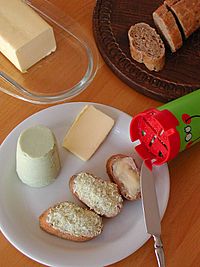Schabziger facts for kids
Quick facts for kids Schabziger |
|
|---|---|
 |
|
| Country of origin | Switzerland |
| Region, town | Glarus |
| Source of milk | Cows |
| Pasteurized | No |
| Texture | Hard |
| Aging time | 2 - 6 months |
| Certification | Since 1463 |
Schabziger (say it "SHAP-tsig-er") or sapsago is a very special and old type of cheese from Switzerland. It's made only in a place called the Canton of Glarus. What makes Schabziger unique is that it's made from cow's skimmed milk (milk with almost no fat) and a special herb called blue fenugreek. This herb gives the cheese its green color and strong, unique taste.
Contents
How Schabziger is Made
Schabziger cheese is made using a traditional method that has been followed for hundreds of years. It starts with skimmed cow's milk, which means most of the fat has been removed.
From Milk to Cone
First, the skimmed milk is heated to about 32 degrees Celsius (that's around 90 degrees Fahrenheit). Then, a special liquid, like lactic, citric, or acetic acid, is added. This makes the milk curdle, separating into solid bits called curd and a watery liquid called whey.
The curd and whey are then separated. The whey is heated again, this time to a much hotter temperature, about 90 degrees Celsius (around 194 degrees Fahrenheit). This causes even more curd to form from the whey.
The solid part that comes from the whey is called Ziger. This Ziger is pressed into a special cone shape. It stays in these cone shapes for about 6 to 8 days. After that, the cones are dried for a longer time, usually between 2 and 6 months. This drying process helps the cheese develop its hard texture and strong flavor.
What Does Schabziger Look Like?
The finished Schabziger cheese is very hard and has a distinct green color. It also has a strong smell and taste. It's usually sold in small cones that weigh about 100 grams (around 3.5 ounces) and are about 5 centimeters (about 2 inches) tall. This cheese is very low in fat, with less than 3% fat content.
How to Enjoy Schabziger
Schabziger is often eaten in a few different ways. Most people grate it, like you might grate Parmesan cheese.
You can also mix grated Schabziger with butter to make a tasty herb spread. This spread is called "Ankeziger" or "Zigerbutter" and is great on bread or sandwiches.
Sometimes, Schabziger is used in a Swiss dish called fondue, which is then called Zigerfondue. It can also be grated and mixed with noodles, known as Zigerhörnli, or with rösti, a popular Swiss potato dish. A cone of Schabziger can stay fresh in the fridge for several weeks.
A Cheese with a Long History
Schabziger cheese has a very long and interesting history. It was first mentioned being sold in the markets of Zürich way back in 1429.
The exact rules for how to make this cheese were officially written down in 1463 during a special meeting called a Landsgemeinde. This was a public assembly where people in Glarus made important decisions. The cheese also had to have a special stamp to show where it came from. This makes Schabziger one of the very first food products to have its origin protected, like a brand name today!
Where Schabziger is Made and Sold
Today, Schabziger is made only by one company called Geska (Gesellschaft Schweizer Kräuterkäse-Fabrikanten).
When it's sold outside of Switzerland, it's often called Swiss Green Cheese. In the United States, you might find it under the name Sap Sago. This name "Sap Sago" came about in the 1800s when the cheese was introduced in pharmacies in New York. The name is a slightly changed version of the German word Schabziger. Some people used to think the green herb juice used to make the cheese was called "sap," like tree sap, which led to the name "Sap Sago."

